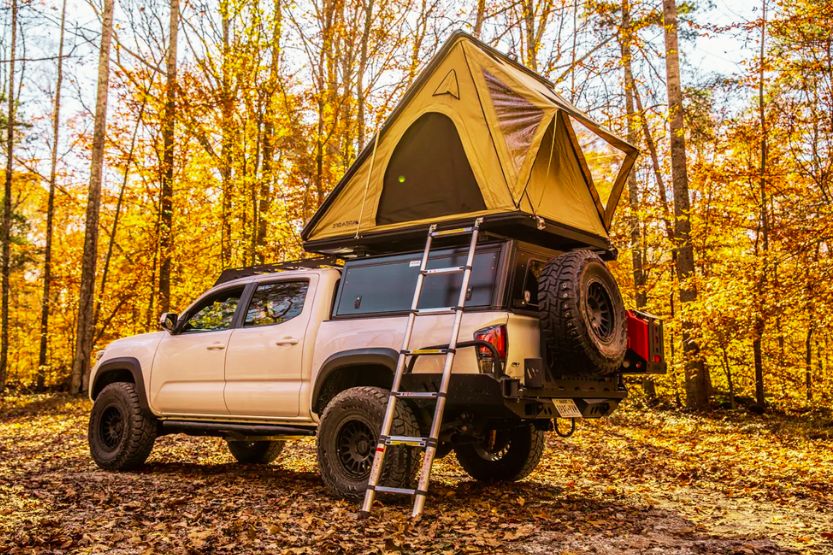A rooftop tent, or RTT, is an expensive and complicated product to buy. If you don’t do your homework, you will end up in a tent that is not functional. So, what should you consider before you buy one?
You need to consider certain factors before you buy an RTT, such as the size and weight of the tent, mounting system, ventilation, accessories, and seasonal variations. You must also consider the warranty, roof rack arrangement, tent ladders, safety, and security. Above all, you’ve got to know which type of tent you need and how to mount it on a trailer properly.
Read on to learn more about rooftop tents and all you need to know before you buy one and mount it on your trailer.
What Is a Rooftop Tent (RTT)?

An RTT is a tent you can attach to a trailer and use while off-roading. While there are many types of tents to choose from, tents are still not for everyone. This is why the logistics of owning one are of vital importance.
Remember that getting up in the middle of the night or going to bed will require you to climb a ladder. You must either hand someone the items that will go into your tent or climb the ladder.
This can be particularly challenging for people with injuries, disabilities, or large pets. There is also no getting over that you will be crawling, leaning, climbing, and stepping all over your vehicle a LOT.
This does not mean that installing a rooftop tent would harm you. While they can be heavy and need time to assemble, mounting an RTT on a utility trailer should not be that difficult.
Of course, you will need some assistance if you can’t load a heavy 100+ lb load onto your vehicle. Sometimes, having the tent professionally installed will be a good idea.
Factors to Consider Before You Buy an RTT
Let’s look at some of the factors you should consider when buying an RTT:
1. Size
The fit of the rooftop tent is one of the most important things to consider, so you should be aware of your vehicle’s dimensions before you buy an RTT.
You can always check the exact size of your vehicle by going to the owner’s manual or doing a quick online search, where you can select the appropriate tent size.
Moreover, you can seek advice from the seller and find some size charts in the rooftop tent’s instructions.
2. Weight
The tent’s weight can be a significant issue for those driving smaller vehicles. However, this is probably less of a problem for those driving larger trucks and SUVs. It is also important to remember that you will eventually have to pull the tent onto or off your vehicle.
The extra 20 or 30 pounds can be vital if you often intend to do this. However, increased durability usually comes with increased weight, which makes sense.
A heavier model can be worth the extra weight if you frequently use the tent, whether off-road, at festivals, or on several road trips.
3. Mounting System
Depending on your vehicle, rack, and intended use, the mounting system that comes with your tent is also important. A tool-free solution will be the best option if you plan to remove the tent from your car regularly.
Also, the width and spacing of crossbars and racks that the tool-free system may accommodate will be restricted. If you want a durable and adaptable mounting solution, buy a tent with standard track mounts.
4. Ventilation
The tent should be well ventilated. The majority of rooftop tents come with at least one window so that you can choose one of those. You’ll be able to breathe easily and take in clean outdoor air.
5. Seasons
It is essential to take into account the sort of weather you will experience while camping. If you travel to a place like Moab in July, you will most likely not require the same kind of canopy as a person traveling to the Cascades in April.
On hot days, a heavier canopy could leave you frying because breathability is so important in high temperatures. So, in light of this, choose a 4-season model if you want a tent that can withstand any weather while providing adequate ventilation.
Generally speaking, most RTTs features a detachable rainfly, but the 4-season models will not need one in light rain due to their taped seams and waterproof canopies.
6. Accessories
A wide variety of RTTs accessories can come in handy when camping. These include LED lighting, internal storage, boot bags, and changeable canopies.
You should pick a tent with all the extra features and accessories that come with it if you’re the kind of person who enjoys having all the bells and whistles.
Remember that some RTTs come with installed attachments, while others will cost you a little bit to upgrade.
7. Roof Rack Arrangement
Your rack must have ample capacity for dynamic and static use, much like your roof. Double-check this one before buying and using a rooftop tent.
8. Warranty
Check the limitations and restrictions of the warranty. While some manufacturers offer 12-month contracts with regulations, others provide inclusive durations of up to five years.
Choose a tent with replaceable parts so that if something breaks, you can replace it without having to disassemble and transport the entire tent, or worse, having to return your whole tent.
9. Mattress
Most RTT mattresses are high-density foam with a maximum thickness of 5 cm. The likelihood that your hips and shoulders may press into the hard floor or that you’ll lie in awkward postures and run the danger of injuring your back increases with mattress thickness.
Ideally, it would help if you went for a 100mm-thick mattress with a convoluted upper. Such mattresses are more prevalent in RTTs with hard lids because they prevent the mattress from folding in on itself during storage.
Remember that mattresses that fold will lose durability in the center. We recommend leaving the wavy “egg-crate” foam upper layer inside for maximum comfort.
10. Security and Privacy
Sometimes, leaving your vehicle at a trailhead or parking lot for a long time is necessary because not everyone has a garage. If so, it would be a good idea to buy a tent that is well secured. Let’s face it; you are somewhat exposed to bystanders in terms of privacy.
Some tents have sizable awnings and annexes to give you a private space to change, shower, or hang out at a busy campground or event.
11. Ladders
There are two types of ladders available: telescoping and sliding ladders. While sliding ladders are more durable, telescoping ladders are more adaptable. Tents that come with this kind of sliding ladder are typically less expensive.
12. Installation
Make sure you understand how to mount the rooftop tent to avoid any potential camping problems. Setting up your second home in your vehicle is slightly tricky, but when you know precisely what you are doing, you can set it up quickly.
Two Types of RTT
Let’s go briefly over the two types of tents you are going to choose from:
1. Hard-shelled RTT
Tents with hard shells are rigid outer material that combines fiber, aluminum, and plastic.
Hard-shelled tents are dependable and functional no matter how harsh the weather is. Moreover, hard-shelled tents are simple to mount because they have permanent parts.
Because they are built of very durable materials, hard-shelled tents can last for a very long time. You do not need to be as careful with them as you would with soft-shelled ones.
2. Soft-shelled RTT
Soft-shelled tents require a lot of attention because they are super light due to their soft fabric. If you use them carelessly, you risk damaging them.
Soft-shelled tents are made of textiles and other soft materials that offer advantages and disadvantages. One of the benefits of soft-shelled tents is that it is pretty handy because it is made of durable and soft fabrics.
You can set it up on your vehicle without worrying too much about the roof because it is not as hefty as hard-shelled tents. With that being said, setting up a soft-shelled tent takes a little longer than a hard-shelled one is one of its drawbacks.
Soft-shelled tents are less expensive than hard-shelled ones, so if you’re new to camping and unsure if you’ll find it exciting, this tent will serve your purpose well.
Again, what is RTT on a trailer? Some trailers can accommodate rooftop tents (RTT). These tents provide sleeping space for two or more people. But, they are often more expensive than regular ones.
What Are the Pros and Cons of Having an RTT?

Pros
1. Safety
There are many creepy crawlies that are hungry for blood, whether you’re in the mountains or the desert. Seriously though, it feels incredible to be off the ground after having a long hike. However, don’t count on your rooftop tents to protect you from a grizzly that wants to devour you or your munchies.
You can detach your rooftop tent trailer, set up camp, and then explore the area by mounting your rooftop tent on a trailer.
2. Simplicity
You can usually set up an RTT fast and without much difficulty. Soft-shelled tents require a little clambering around the vehicle while the cover is being unzipped. But, not having to worry about the stony, damp, muddy, or snowy ground is incredibly significant.
All you are looking for is a reasonably level place. On the other hand, you can still use leveling blocks on uneven ground, as this should do the trick.
Above all, RTTs is quicker than setting up a ground tent, which is incredibly convenient after a tardy arrival at camp or a long day in the saddle.
3. Comfort
This is a matter of personal preference, but most RTTs feature a 2-3″ wall-to-wall foam mattress that is usually quite comfortable to sleep on—no more waking up in the middle of the night to remove your sleeping pad. Cheap tents often feature foam of inferior quality.
4. Bedding Storage
Some rooftop tents allow you to keep your bedding inside of them while on the road. This extra storage is handy for owners of lower-capacity vehicles like Jeeps.
Cons
1. Increases Fuel Burn
Along with increased fuel consumption, towing a trailer puts a more significant strain on your vehicle. This is especially true when you pull your RTT trailer across rugged terrain.
2. Extra Fees for Registration and Insurance
An RTT requires license plates, insurance, and the initial cost of buying a trailer.
3. Needs to be Stored
You will need to find another location to keep it if you don’t have enough room in your garage or backyard, which could add to the cost and hassle.
4. Difficult to Maneuver
When you have a rooftop tent on your trailer, backing up, turning around, and navigating trails become slightly more challenging.
5. Stability
You can feel it up there when driving on the interstate and, most definitely, when driving on winding roads since it raises your vehicle’s center of gravity. However, it is a bigger concern while off-road, especially on off-camber paths.
You will certainly need to leave it at home and bring a ground tent if you know you will visit places that call for a lot of rock crawlings, such as Moab trails or something.
6. Longer Setup Times
When you mount an RTT on top of your trailer, it usually has a quick setup time that makes it appealing. But, soft-shelled tents will need some extra time due to backing up, leveling, etc.
Additionally, if you include an annex or an awning, the setup time will increase too. However, these new additions will enhance the convenience and comfort of your tent.
7. Removal
This requires two people to complete and takes time. Most people leave it 90% of the time because it is a hassle and makes it tough to store things at home. Some people may buy or assemble complex pulley systems in their garages to make the process easier and quicker.
How to Mount an RTT on a Trailer
Materials
You are going to need the following tools for a proper setup:
- Ladder
- Box cutter
- Bolts with washers
- Tent cover
- Steel mounting plates
- Channel slides (with nuts and bolts)
- Ladder brackets
- Wrenches
Steps
1. Get Your Trailer Ready
Once you get your RTT, you must set it on a stable, clean surface. So, clear your trailer of any clutter. You’ll also need stabilizers to make your surface steady.
If you don’t already have stabilizers, look for ones that match the specifications of your trailer and buy them online.
2. Install the Mounting Tracks
You will need to put mounting tracks perpendicular to the crossbars or rails of your roof rack system when you install them. By so doing, they will be simple to attach to the sidebars.
Moreover, it would help if you secured your mounting tracks in place, and you can use washers to help you do this. Place them on each bolt and slowly insert each one until it clicks in place.
3. Use Your Ladder
You must flip the trailer over after attaching your tracks and setting your RTT on it.
Use the ladder that came with your RTT to do this.
If it were a separate item, you would need to attach the ladder to the tent first. To do so, place the ladder brackets over the RTT’s edge holes that have already been pre-drilled.
Before attaching the ladder to your tent, remove the bolts from the brackets.
4. Cover
Once your ladder functions correctly, you should re-secure your RTT to your trailer. Use your RTT’s C-channel, which you can find on the side.
5. Positioning
It’s time to adjust the RTT’s position if necessary now that it is on top of your trailer.
You can insert two-channel sliders and the supplied bolts into each end of the mounting tracks.
Once you are done, raise your RTT a little bit and then shuffle the slide/bolt assembly so that there is one on each side.
Do this for every section of the mounting track and the intersection of the crossbars.
7. Secure Your Roof Rack
You’ll need steel mounting plates, four of them, to secure your roof rack.
Put them underneath each set of mounting channel sliders, fasten them with the included nuts, and then tighten them with a tool, and you are good to go!
How Can You Use an RTT?

Now that you know how to mount an RTT on your trailer, there are two ways you can use it:
Fold-out
This typically applies to soft-shelled tents. You remove the travel cover, bring the ladder, and the tent opens. You just then need to adjust the ladder to the floor.
Pop-up
This applies to hard-shelled tents. You latch the tent up into place, and that’s it.
Is Buying an Airstream Worth It?
How Long Does It Take a Rooftop Tent to Open?
On average, most rooftop tents can open and be ready for use in three to four minutes. Opening the tent, setting up the windows, and installing the rainfly rods may take 4-6 minutes.
Hard-shelled tents are typically quicker to set up because they don’t have additional features like rain fly rods.
So, Should You Buy an RTT?
RTTs have gained popularity recently as the range of vehicle camping supplies has expanded. You are getting a standard ground tent and a heavy hard camper all in one place.
Moreover, you can set it up in a matter of minutes. To access the tent, all you need to do is climb the ladder which comes along with the package. The tent has drawbacks, but it also is way more comfortable than a ground tent.
Thanks to its easy setup, you have more time to do the things you enjoy, which is why it is undoubtedly a good buy. Its other benefits include the following:
- Low cost in comparison to other solutions
- It doesn’t let much dirt inside
- It has a fixed mattress of its own
- Provides space to store sleeping bags
- It offers excellent protection when you’re camping
Conclusion – All You Need to Know Before Buying an RTT
Rooftop tents make it possible to sleep almost anywhere and keep your vehicle mobile on and off-road. It’s still not as comfy as a full-size RV or camping trailer. Remember to go over the following one by one before you buy an RTT:
- Size and weight of the tent,
- Mounting system,
- Ventilation,
- Accessories,
- Seasonal variations,
- Warranty,
- Roof rack arrangement,
- Tent ladders.
Above all, mounting an RTT on your trailer is easy. You will undoubtedly find it more pleasant to camp up there than in a ground tent, let alone it pops up more quickly.
Read next:


![Loaner Car [What Is It? Tips for Buying a Loaner Car] loaner car](https://roadsumo.com/wp-content/uploads/2021/06/loaner-car-150x150.jpg)
![Clearance Tires at Walmart [How Much Are They? Buying Guide] clearance tires at walmart](https://roadsumo.com/wp-content/uploads/2022/04/clearance-tires-at-Walmart-150x150.jpg)

![How Does Vroom Work? [Buying and Selling] how does vroom work](https://roadsumo.com/wp-content/uploads/2022/04/how-does-Vroom-work-150x150.jpg)

![Read more about the article Truck Bed Cargo Bag [8 Best Waterproof Bags]](https://roadsumo.com/wp-content/uploads/2021/03/truck-bed-cargo-bag-300x200.jpg)

